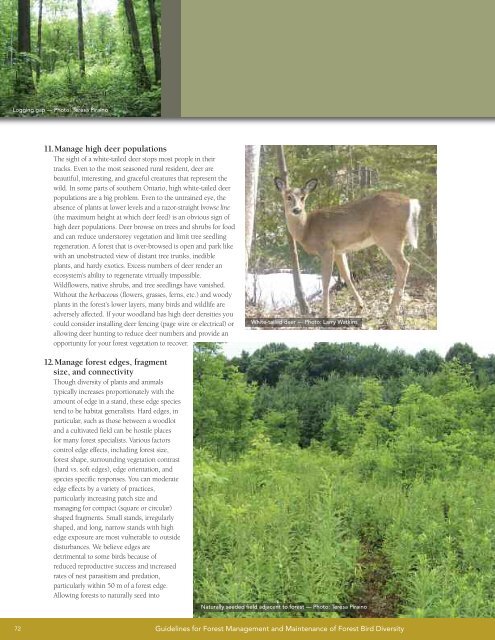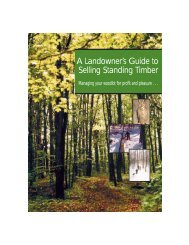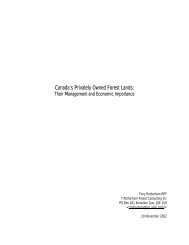A land manager's guide to conserving habitat for forest birds in ...
A land manager's guide to conserving habitat for forest birds in ...
A land manager's guide to conserving habitat for forest birds in ...
Create successful ePaper yourself
Turn your PDF publications into a flip-book with our unique Google optimized e-Paper software.
Logg<strong>in</strong>g gap — Pho<strong>to</strong>: Teresa Pira<strong>in</strong>o<br />
11. Manage high deer populations<br />
The sight of a white-tailed deer s<strong>to</strong>ps most people <strong>in</strong> their<br />
tracks. Even <strong>to</strong> the most seasoned rural resident, deer are<br />
beautiful, <strong>in</strong>terest<strong>in</strong>g, and graceful creatures that represent the<br />
wild. In some parts of southern Ontario, high white-tailed deer<br />
populations are a big problem. Even <strong>to</strong> the untra<strong>in</strong>ed eye, the<br />
absence of plants at lower levels and a razor-straight browse l<strong>in</strong>e<br />
(the maximum height at which deer feed) is an obvious sign of<br />
high deer populations. Deer browse on trees and shrubs <strong>for</strong> food<br />
and can reduce unders<strong>to</strong>rey vegetation and limit tree seedl<strong>in</strong>g<br />
regeneration. A <strong>for</strong>est that is over-browsed is open and park like<br />
with an unobstructed view of distant tree trunks, <strong>in</strong>edible<br />
plants, and hardy exotics. Excess numbers of deer render an<br />
ecosystem’s ability <strong>to</strong> regenerate virtually impossible.<br />
Wildflowers, native shrubs, and tree seedl<strong>in</strong>gs have vanished.<br />
Without the herbaceous (flowers, grasses, ferns, etc.) and woody<br />
plants <strong>in</strong> the <strong>for</strong>est’s lower layers, many <strong>birds</strong> and wildlife are<br />
adversely affected. If your wood<strong>land</strong> has high deer densities you<br />
could consider <strong>in</strong>stall<strong>in</strong>g deer fenc<strong>in</strong>g (page wire or electrical) or<br />
allow<strong>in</strong>g deer hunt<strong>in</strong>g <strong>to</strong> reduce deer numbers and provide an<br />
opportunity <strong>for</strong> your <strong>for</strong>est vegetation <strong>to</strong> recover.<br />
White-tailed deer — Pho<strong>to</strong>: Larry Watk<strong>in</strong>s<br />
12. Manage <strong>for</strong>est edges, fragment<br />
size, and connectivity<br />
Though diversity of plants and animals<br />
typically <strong>in</strong>creases proportionately with the<br />
amount of edge <strong>in</strong> a stand, these edge species<br />
tend <strong>to</strong> be <strong>habitat</strong> generalists. Hard edges, <strong>in</strong><br />
particular, such as those between a woodlot<br />
and a cultivated field can be hostile places<br />
<strong>for</strong> many <strong>for</strong>est specialists. Various fac<strong>to</strong>rs<br />
control edge effects, <strong>in</strong>clud<strong>in</strong>g <strong>for</strong>est size,<br />
<strong>for</strong>est shape, surround<strong>in</strong>g vegetation contrast<br />
(hard vs. soft edges), edge orientation, and<br />
species specific responses. You can moderate<br />
edge effects by a variety of practices,<br />
particularly <strong>in</strong>creas<strong>in</strong>g patch size and<br />
manag<strong>in</strong>g <strong>for</strong> compact (square or circular)<br />
shaped fragments. Small stands, irregularly<br />
shaped, and long, narrow stands with high<br />
edge exposure are most vulnerable <strong>to</strong> outside<br />
disturbances. We believe edges are<br />
detrimental <strong>to</strong> some <strong>birds</strong> because of<br />
reduced reproductive success and <strong>in</strong>creased<br />
rates of nest parasitism and predation,<br />
particularly with<strong>in</strong> 50 m of a <strong>for</strong>est edge.<br />
Allow<strong>in</strong>g <strong>for</strong>ests <strong>to</strong> naturally seed <strong>in</strong><strong>to</strong><br />
Naturally seeded field adjacent <strong>to</strong> <strong>for</strong>est — Pho<strong>to</strong>: Teresa Pira<strong>in</strong>o<br />
72<br />
Guidel<strong>in</strong>es <strong>for</strong> Forest Management and Ma<strong>in</strong>tenance of Forest Bird Diversity

















